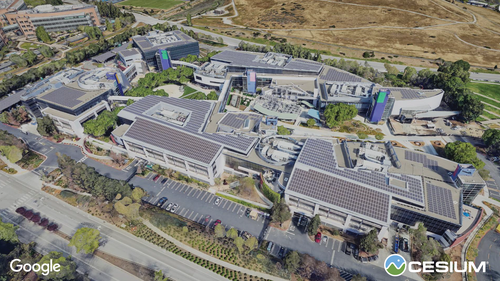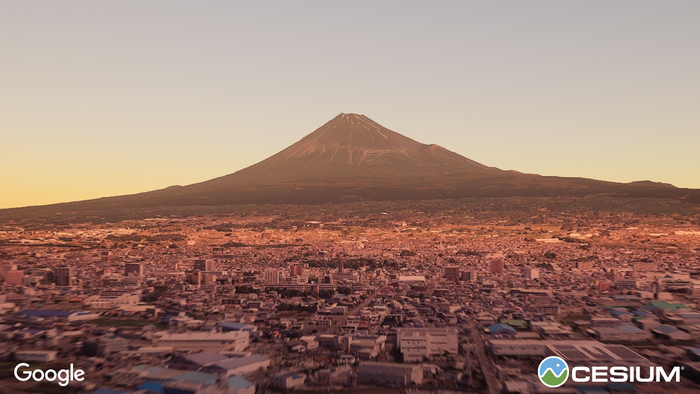Last month, Cesium announced a new partnership with Google Maps Platform, who will be using the former 3D Tiles to render its new Photorealistic 3D Tiles through their Maps API. Cesium’s 3D Tiles are the Open Geospatial Consortium’s 3D Tiles standard, and will now be used with Google Maps Platform’s massive dataset, which is available for over 2500 cities and 49 countries. With the partnership, developers will be able to “use Cesium ion to combine their own 3D geospatial data to build immersive metaverse experiences with Photorealistic 3D Tiles,” per the announcement of the news.
Recently, Geo Week News spoke to Lisa Bos, a Senior Product Manager with Cesium, about what the partnership means for the developer community, as well as 3D Tiles in general, and how they became the standard. Bos has been with Cesium for three years, and has extensive experience in her career working with large datasets, working towards standards and interoperability.
What are 3D Tiles?
As Bos explains, any individual 3D object has traditionally been a glTF file, but that simply allows one to look at the object in 3D space without “existing in any context.” That was the early problem that Cesium set out to solve, looking to provide that crucial geospatial context. It was a worthy goal, but also a lofty one, requiring a format to allow a user to not only see one view or part of whatever area is of importance, but being able to seamlessly scale up and down based on need.
3D Tiles, which were first unveiled in 2015, are able to accomplish this by arranging this data as a set of tiles in a spatial hierarchy, known as a tree. Starting at the largest dataset for a given geospatial area – say, the entire globe, a continent, or a country – and zooming in on smaller nodes while maintaining the necessary level of detail, with the appropriate metadata available. They’re able to keep a smooth user experience while zooming in and out of data by only streaming visible tiles, showing only the most important tiles for a given view. Bos sums it up, saying, “It’s the bringing together of a bunch of standards that are familiar to application developers,” things like glTF and JSON files, “but in a way that allows super efficient performance render.”
Becoming the OGC Standard
One of Cesium’s core philosophies, backed up with things like their Cesium Ecosystem Grants, is the idea of openness and standards, making the 3D geospatial ecosystem as collaborative and interoperable as possible. So it’s no surprise they have worked closely with the Open Geospatial Consortium, whose mission is to provide key standards throughout the geospatial community. In 2019, they announced that 3D Tiles had become a community standard. Bos explains that this was not a short process – which is typical for this kind of standardization decision – as the OGC worked with both Cesium and the community to ensure that 3D Tiles were indeed providing what was needed in the industry.

More recently, last month, the OGC announced that they have approved version 1.1 of 3D Tiles (previously known as 3D Tiles Next) have become the new community standard for the geospatial industry. As noted in the OGC’s announcement of the news, the primary enhancements in the 3D Tiles version 1.1 are as follows:
- Semantic metadata at multiple granularities;
- Implicit tiling for improved analytics and random access to tiles;
- Multiple contents per tile to support layering and content groupings; and
- Direct references to glTF™ content for better integration with the glTF™ ecosystem.
The New Partnership with Google Maps Platform
Of course, what we’ve touched on so far has been established in the 3D geospatial ecosystem already, but this new announced partnership with Google Maps Platform has the potential to take things to a new level. For one thing, Google Maps Platform possesses a massive amount of data, of which developers using 3D Tiles can now take advantage. This was the result of a two-years collaboration with Google, and both Bos and Cesium as a whole express quite a bit of excitement about the potential.
She explains that, like many other tech companies today, Google is looking towards spatial computing and spatially based apps as the future, and they wanted to “both make their data available because they have the biggest representation of the globe, and also wanted to ensure they were part of” this next generation of spatially-based applications.
Talking about how this data is already, and could potentially, be used with the new implementation of 3D Tiles, Bos points to a couple of examples. One is the type of thing that is often shared on social media, things like Godzilla walking through a photorealistic city, which is cool but not super useful. More practically, she also points to industries like architecture and real estate already making Google data available to “provide context to their more detailed data to a digital twin for a particular city, or a housing development.” With that, they are able to provide key context and allow customers and clients to understand their work in ways that simply weren’t possible before.
With any merging of technologies like this, it’s inevitable that use cases will pop up that are unforeseen and surprising, as well industries that aren’t currently part of the ecosystem joining in. No one can reasonably be expected to predict how things will turn out, especially just a month after this announcement.
That said, if we were to describe Bos’ outlook in one word, it would be excitement. She points to this new announcement as the source, along with Cesium’s runtimes with Unity, Unreal, and NVIDIA’s Omniverse, and the experimentation they’re already seeing in these areas, “each of which has its own personality.” She continued, “That has just been really thrilling for us.”






